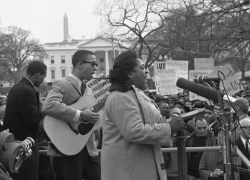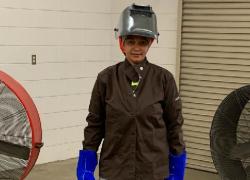En español
Black women have been on the forefront of the fight for labor rights for decades, helping improve conditions for all of America’s workers. Historically excluded from many good jobs, they’ve performed much of the essential but difficult work underpinning our economy without the protections afforded to other workers. For example, the Social Security Act of 1935 initially excluded domestic workers — the majority of whom were Black women.
While there are countless women who have organized and advocated for better working conditions, here are a few you should know.
Dorothy Bolden

Dorothy Bolden began helping her mother with domestic work at age 9. She was proud of her work but also knew how grueling it could be, and wanted domestic workers to be seen and respected as part of the labor force. Dr. Martin Luther King Jr., her next-door neighbor, encouraged her to take action. In 1968 she founded the National Domestic Workers Union, helping organize these workers on a scale never seen before in the U.S. The union taught workers how to bargain for higher wages, vacation time and more. She also required that all members register to vote, helping give workers’ both a stronger voice on the job and in Georgia policy.
Nannie Helen Burroughs

Nannie Helen Burroughs was a suffragist, educator and organizer, as well as a mentor to the Rev. Martin Luther King Jr., who worked to integrate labor reform into the movement for voting rights. She launched the National Association of Wage Earners in 1921, a labor union for Black domestic workers. Burroughs also established the National Trade School for Women and Girls to combat labor exploitation through education, helping improve working conditions and expand career pathways for Black women.
Melnea Cass

Known as the “First Lady of Roxbury,” community organizer and activist Melnea Cass helped provide social services, professional training and labor rights education that empowered Boston’s most vulnerable workers. One of many examples is a program she co-created that provided childcare for working mothers. Her advocacy also helped achieve a major legislative victory: In 1970, Massachusetts passed the nation’s first state-level minimum wage protections for domestic workers since the Great Depression.
Clara Day

As one of 11 children – including three sets of twins – Clara Day took naturally to collective action and coalition building. As an information clerk at Montgomery Wards, she resented the segregation of white and black employees, which led her to push for change. Clara Day first began organizing co-workers at Montgomery Ward in 1953 and went on to hold several roles in the Teamsters Local 743. She also helped found the Coalition of Labor Union Women and the Teamsters National Black Caucus. A passionate advocate for labor, civil and women’s rights, she helped bring attention to issues like pay equity and sexual harassment.
Anna Arnold Hedgeman

A civil rights activist, educator and writer who helped organize the March on Washington for Jobs and Freedom, Anna Arnold Hedgeman was a lifelong advocate for equal opportunity and employment. She persuaded the organizers to include economic issues in the demonstration (the “Jobs” part) in addition to civil rights. The only woman on the event's administrative committee, she also fought to ensure women were included women in the day’s program.
Dora Lee Jones

Dora Lee Jones helped found the Domestic Workers Union in Harlem in 1934 in defiance of New York City’s “slave markets,” as they were known. With few employment options during the Depression, Black women would gather daily in the morning at certain locations and wait for white middle-class women to hire them, typically for terrible wages. The union called for a minimum wage, overtime, two weeks’ notice for termination – and no window washing. (Workers were regularly asked to perform the dangerous task of cleaning the outside of upper-floor apartment windows.) The DWU eventually affiliated with the predecessor to today’s Service Employees International Union.
Maida Springer Kemp

Maida Springer Kemp worked as a labor organizer in the garment industry and became the first Black woman to represent the U.S. labor movement overseas in 1945 when she visited post-war Britain on a labor exchange trip. She went on to spend many years liaising between American and African labor leaders as a member of the AFL-CIO, affectionately known as “Mama Maida” for her work. Throughout her life she advocated for civil rights and women’s rights in America and internationally.
Rosina Corrothers Tucker

Rosina Corrothers Tucker helped establish the Brotherhood of Sleeping Car Porters — the nation’s first predominantly Black labor union — and its International Ladies’ Auxiliary Order. The BSCP became the first Black union recognized by the AFL-CIO in 1935. She also organized workers in the laundry trades and domestic service industries, fought for racial and economic justice as part of the March on Washington movement, and lobbied Congress for labor and education reforms.
These leaders improved working conditions, wages and rights for America’s workers, often at great personal cost. We honor them by continuing the fight for a fair and just workplace for all.
Editor’s note: Want to learn more? Read about these labor leaders and pioneers: Mary McLeod Bethune, Hattie Canty, Fannie Lou Hamer, Dorothy Height, Maggie Lena Walker and Addie Wyatt.
8 mujeres líderes de color que lucharon por los derechos laborales y que deberías conocer
Las mujeres de color han estado al frente de la lucha por los derechos laborales durante décadas y han contribuido a mejorar las condiciones de todos los trabajadores de Estados Unidos. Si bien históricamente se las ha excluido de muchos buenos empleos, han realizado gran parte del trabajo imprescindible, y a la vez difícil, que sustenta nuestra economía sin las protecciones que se conceden a otros trabajadores. Por ejemplo, la Ley de Seguridad Social de 1935 excluía inicialmente a los empleados domésticos, que en su mayoría eran mujeres de color.
Aunque hay una infinidad de mujeres que se han organizado y han abogado por mejores condiciones laborales, aquí se mencionan algunas que deberías conocer.
Dorothy Bolden

Dorothy Bolden empezó a ayudar a su madre en las tareas domésticas a los 9 años. Estaba orgullosa de su trabajo, pero también sabía lo agotador que podía ser, y quería que los empleados domésticos fueran vistos y respetados como parte de la mano de obra. El Dr. Martin Luther King Jr., su vecino de al lado, la animó a intervenir. En 1968, fundó el Sindicato Nacional de Empleados Domésticos, que ayudó a organizar a estos trabajadores a una escala sin precedentes en los Estados Unidos. El sindicato les enseñó a los trabajadores a negociar salarios más altos, vacaciones y mucho más. Dorothy también exigió que todos los afiliados se inscribieran para votar, lo que contribuyó a que los trabajadores fueran más escuchados en el trabajo y en la política de Georgia.
Nannie Helen Burroughs

Nannie Helen Burroughs fue sufragista, docente y organizadora, así como mentora del reverendo Martin Luther King Jr., que trabajó para integrar la reforma laboral en el movimiento por el derecho al voto. En 1921, fundó la Asociación Nacional de Asalariados, un sindicato de empleados domésticos de color. Burroughs también creó la Escuela Nacional de Comercio para Mujeres y Niñas para combatir la explotación laboral a través de la educación, lo que ayudó a mejorar las condiciones de trabajo y a ampliar las salidas profesionales de las mujeres de color.
Melnea Cass

Melnea Cass conocida como la “primera dama de Roxbury”, fue una organizadora comunitaria y activista que ayudó a proporcionar servicios sociales, formación profesional y educación en derechos laborales que empoderaron a los trabajadores más vulnerables de Boston. Uno de los muchos ejemplos es un programa que creó en colaboración con otros que ofrecía servicios de guardería a madres trabajadoras. Su activismo también contribuyó a lograr una importante victoria legislativa: en 1970, se aprobó en Massachusetts la primera ley estatal de protección del salario mínimo para los empleados domésticos desde la Gran Depresión.
Clara Day

Clara Day, que tenía 10 hermanos (entre ellos, tres pares de gemelos), era naturalmente partidaria de la acción colectiva y la formación de coaliciones. Como empleada administrativa de Montgomery Wards, le molestaba la segregación de empleados blancos y negros, lo que la llevó a luchar por un cambio. Comenzó a organizar a sus compañeros de trabajo de Montgomery Ward en 1953 y posteriormente desempeñó varios cargos en el sindicato Teamsters Local 743. También ayudó a fundar Coalition of Labor Union Women y Teamsters National Black Caucus. Apasionada defensora de los derechos laborales, civiles y de la mujer, contribuyó a atraer la atención a cuestiones como la igualdad salarial y el acoso sexual.
Anna Arnold Hedgeman

Anna Arnold Hedgeman, activista de los derechos civiles, docente y escritora que ayudó a organizar la marcha en Washington por el trabajo y la libertad, fue una defensora de la igualdad de oportunidades y de empleo durante toda su vida. Convenció a los organizadores para que incluyeran en la manifestación los problemas económicos (la parte del “trabajo”), además de los derechos civiles. Como única mujer en el comité administrativo del evento, también luchó para garantizar la inclusión de mujeres en el programa de la jornada.
Dora Lee Jones

Dora Lee Jones ayudó a fundar el Sindicato de Empleados Domésticos de Harlem en 1934 a modo de resistencia ante los “mercados de esclavos” de Nueva York, como se los conocía. Como había pocas opciones de empleo durante la Depresión, las mujeres de color se reunían a diario por la mañana en determinados lugares y esperaban a que las mujeres blancas de clase media las contrataran, normalmente por salarios terribles. El sindicato exigía un salario mínimo, horas extraordinarias, dos semanas de preaviso en caso de despido y que no se tuvieran que lavar las ventanas (a los trabajadores se les pedía con frecuencia que realizaran la peligrosa tarea de limpiar el exterior de las ventanas de los pisos superiores). Con el tiempo, la DWU se afilió al predecesor del actual Sindicato Internacional de Empleados de Servicios.
Maida Springer Kemp

Maida Springer Kemp trabajó como organizadora sindical en la industria textil y se convirtió en la primera mujer de color en representar al movimiento obrero estadounidense en el extranjero en 1945, cuando visitó Gran Bretaña en la posguerra en un viaje de intercambio laboral. Durante muchos años actuó de enlace entre los líderes sindicales estadounidenses y africanos como miembro de la AFL-CIO, y se la conoce cariñosamente como “Mama Maida” por su labor. A lo largo de su vida abogó por los derechos civiles y los derechos de la mujer en los Estados Unidos y a nivel internacional.
Rosina Corrothers Tucker

Rosina Corrothers Tucker ayudó a fundar la Brotherhood of Sleeping Car Porters, el primer sindicato conformado predominantemente por personas de color del país, y su International Ladies' Auxiliary Order. La BSCP se convirtió en el primer sindicato de color reconocido por la AFL-CIO en 1935. También organizó a los trabajadores de la lavandería y el servicio doméstico, luchó por la justicia racial y económica en el marco de la marcha en Washington y presionó al Congreso para que se introdujeran reformas laborales y educativas. Estas líderes mejoraron las condiciones laborales, los salarios y los derechos de los trabajadores estadounidenses, a menudo a un gran costo personal. Las homenajeamos al continuar la lucha por un lugar de trabajo justo y equitativo para todos.
Nota del editor: ¿Quieres más información sobre este tema? Lee acerca de estas líderes sindicales y pioneras: Mary McLeod Bethune, Hattie Canty, Fannie Lou Hamer, Dorothy Height, Maggie Lena Walker y Addie Wyatt.

 U.S. Department of Labor Blog
U.S. Department of Labor Blog







